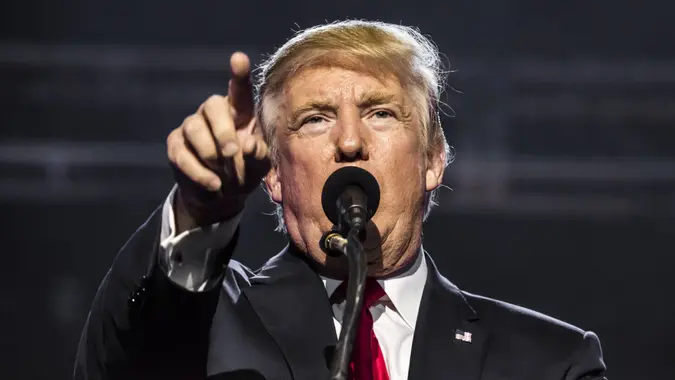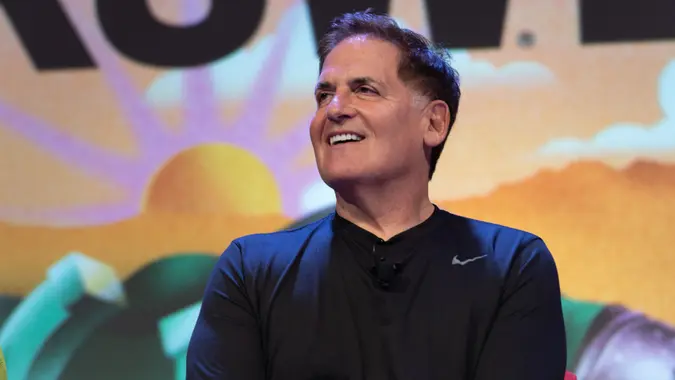What Would Kamala Harris’ ‘Opportunity Economy’ Actually Look Like?

Commitment to Our Readers
GOBankingRates' editorial team is committed to bringing you unbiased reviews and information. We use data-driven methodologies to evaluate financial products and services - our reviews and ratings are not influenced by advertisers. You can read more about our editorial guidelines and our products and services review methodology.

20 Years
Helping You Live Richer

Reviewed
by Experts

Trusted by
Millions of Readers
As part of her broader economic proposals, Vice President Kamala Harris rolled out her “Opportunity Economy” agenda on Aug. 16, which she also touted during the Sept. 10 presidential debate.
“I believe in the ambition, the aspirations, the dreams of the American people. And that is why I imagine and have actually a plan to build what I call an opportunity economy,” Harris said during the debate. The agenda tackles a wide range of economic issues, such as housing, lowering the cost of drugs and groceries, and tax breaks.
Here is what her “Opportunity Economy” plan could look like.
Tax Cuts for the Middle Class
Harris said that Americans earning under $400,000 a year would not pay more in new taxes if she were elected, according to a press release.
In terms of specific tax breaks, she said she would plan to expand the Child Tax Credit with up to $3,600 per child. She also proposed a new $6,000 child tax credit for families with children in the first year of life.
In addition, she’s offered to expand the Earned Income Tax Credit. The expansion would cover individuals and couples in lower-income jobs, cutting their taxes by up to $1,500.
She also intends to cut taxes to help Americans who are buying insurance via the Affordable Care Act Marketplace. Doing so would help Americans save “an average of $700 on their health insurance premiums, totaling over $6,000 per year in savings,” according to the release.
Housing Assistance
In terms of housing assistance, Harris’ proposal includes up to $25,000 down payment assistance for first-time homebuyers, “with more generous support for first-generation homeowners,” according to her campaign website.
In addition, she has proposed lowering rents by “taking on corporate and major landlords,” according to the release.
Finally, if elected, she also intends to call on Congress to pass the Stop Predatory Investing Act, which would reduce the ability of large investors to buy “in bulk” rental homes — a practice that lowers supply and hikes up prices.
Help for Small Businesses
As part of her Opportunity Economy agenda, Harris intends to trigger 25 million new business applications by the end of her first term, should she be elected. To that end, she wants to expand the startup expense tax deduction, according to her campaign website.
Harris also has plans to “increase the share of federal contract dollars going to small businesses.”
Lowering Prescription Drug and Grocery Costs
“As President, she will direct her Administration to crack down on anti-competitive practices that let big corporations jack up prices and undermine the competition that allows all businesses to thrive while keeping prices low for consumers,” according to Harris’ campaign website. To achieve this, Harris has proposed extending the cap on the cost of insulin and prescription drug prices to all Americans.
In terms of lowering grocery prices, Harris said she would plan to go “after bad actors to bring down Americans’ grocery costs and keep inflation in check,” per the press release. To that end, she’s proposed implementing a federal ban on price gouging food and imposing penalties on companies that don’t abide by the rules.
Affordable Child Care and Long-Term Care
Harris’ agenda also includes providing more access to affordable child care and long-term care.
As part of that, Harris plans to expand “high-quality home care services for seniors and people with disabilities” and ensure that “hardworking families can afford high-quality child care,” according to her website.
Support for Innovation and Workers
If Harris were to be elected, she plans to continue building on the work she has done with President Biden, including the Bipartisan Infrastructure Law, the CHIPS and Science Act, the Inflation Reduction Act, and the American Rescue Plan. These programs, according to her campaign website, have “supported more than 60,000 infrastructure projects, spurred more than $900 billion in private sector investments, and doubled investments in construction of new manufacturing facilities.”
In addition, Harris said she would support innovation in sectors such as semiconductors, clean energy and artificial intelligence.
Harris’ website claims that she knows “unions are the backbone of the middle class.” In turn, she plans to sign pro-union legislation, “including the PRO Act to support workers who choose to organize and bargain and the Public Service Freedom to Negotiate Act to make the freedom for public service workers to form unions the law of the land.”
Finally, she also said she would work to raise the minimum wage, implement paid family and medical leave, and end taxes on tips for service and hospitality workers.
Affordable Education
In terms of education, Harris said that she would lower costs for child care and preschool, as well as continue to work to “end the unreasonable burden of student loan debt and fight to make higher education more affordable, so that college can be a ticket to the middle class,” according to her website.
What Are the Potential Challenges?
Mark Friedlich, Esq., CPA, the vice president of government affairs at Wolters Kluwer Tax & Accounting, said that this agenda is based on the positions Harris and her campaign took during the debate and also incorporates proposals included in Biden’s budget released earlier this year that Harris has supported.
“Details of the ‘opportunity economy’ will evolve, and the implementation of many of her proposals will require congressional approval,” he said. Friedlich added that these might encounter some implementation challenges, such as securing bipartisan support for major policy changes and balancing increased government spending with concerns about the national debt.
In addition, he noted that this agenda might encounter resistance from large corporations and high-income individuals facing tax increases. Additional challenges, he said, might be coordinating federal, state and local efforts for nationwide implementation, as well as ensuring equitable distribution of benefits across diverse communities and geographic regions.
Editor’s note on election coverage: GOBankingRates is nonpartisan and strives to cover all aspects of the economy objectively and present balanced reports on politically focused finance stories. You can find more coverage of this topic on GOBankingRates.com.
 Written by
Written by  Edited by
Edited by 

























